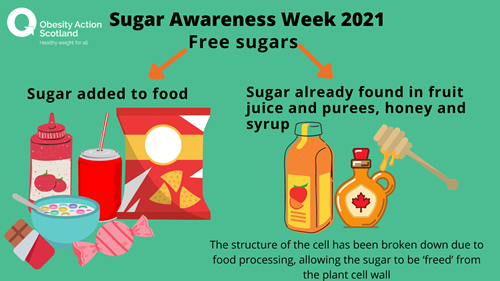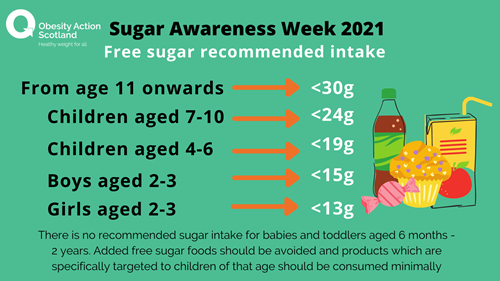Sweet, Sweet Snacks
08 November 2021
Snacks have an impact on our diets and the diet of our children, depending on the snacks we choose. The drive of convenience and marketing make snacks a big business and the healthfulness of those snacks can vary dramatically. Reflecting this, Action on Sugar have chosen the theme of children’s snacks for this year’s Sugar Awareness Week.
As part of Sugar Awareness Week, we tuned into the “Taking Action on Sugar: Children’s Snacks” webinar hosted by My Nutri Web with Action on Sugar, which highlighted the latest research and policy recommendations for children’s snacks. Children are confronted with an abundance of ‘eating occasions’ in which foods lacking in nutritional quality and high in free sugars, are becoming more readily available, contributing to an increase in overall energy intake and detrimentally impacting upon health.

The impact of free sugars upon children’s health is important to address, as they are associated with a greater risk of tooth decay, and an increased risk of type 2 diabetes. Furthermore, consuming free sugars increases energy intake which heightens the risk of overweight and obesity. The prevalence of excess weight among children is at an alarming rate. In Scotland, 23% of Primary 1 children were at risk of overweight or obesity, with 10% specifically at risk of obesity.

Daily sugar intake for children exceed current recommended levels. The current advice on snacking for babies and children highlights that babies from weaning age to 12 months, should not incorporate snacks into their diets, and those 12 months and over can move onto a ‘normal’ diet of three meals and two nutritious snacks per day. This is confounded however by the abundance of children’s snacks currently available on the market from fruit yoghurts to dried fruit bars, all of which are high in sugar and contribute to children’s sugar intake. There has also been a notable rise in different names given to sugar by the food and drinks industries, in an attempt to lure consumers in with ‘cleaner’ or seemingly ‘healthier’ types of sugar within products, using words such as ‘raw’ or ‘organic’ to describe the type of sugar used, or incorporating ‘date syrups’ and ‘fruit juice concentrates’ or ‘purees’ into the ingredients lists. Furthermore, manufacturers cannot use artificial sweeteners in products for babies and young children which further adds to the abundance of alternative free sugars incorporated into children’s snacks by the food and drink industries. Action on Sugar stated that more research is needed around these different types of sugars by exploring and comparing their nutritional quality and effects on health.
Government action on children’s snacks
- The Sugar Reduction Programme, which is part of the Childhood Obesity Plan, was published in 2016 and managed by Public Health England as a voluntary programme, to facilitate a healthier food environment and achieve the aim of reducing the sugar content of popular children’s food products by 20% by 2020. The product categories included breakfast cereals, biscuits, cakes, yoghurts and sweet spreads and sauces with the hope of reformulating, reducing portion sizes or creating healthier, lower sugar snacks options. After three years of the programme, from 2016-2019, only an overall 3% reduction was achieved, with minimal reductions in the sweet and chocolate confectionary category (0.1% and 0.4% respectively). However, a higher reduction (13.3%) was achieved in breakfast cereals through reformulation to reduce the sugar content. The progress report for the final year will be released soon, in which we should expect to see the next stage of the programme.
Read more about the Sugar Reduction Programme here
- The Calorie Reduction Programme was introduced to challenge the food industry to decrease the amount of calories within foods consumed by families by 20% by 2024. This includes snack categories consumed by children such as ready meals, savoury snack products and out of home children’s meal bundles which are the main contributors to calorie intake or excess calorie intake in children. No progress reports have yet been published. This programme targeted the food and drinks industry to change the trend of producing large portion sizes and incorporating calorie dense, nutrient poor ingredients in order to create a healthier food environment.
Read more about the Calorie Reduction Programme here
- Unhealthy Food and Drink Place and Price Promotions Restrictions will be introduced in England from next year (2022) and restricts categorised products which feature high amounts of sugar, salt and fat (HFSS) which are covered by the Sugar and Calorie Reduction Programmes. The UK spend more on food and drinks promotion than any other European country and influence purchasing habits tremendously, through BOGOFs (buy one get one free offers), end of aisle and checkout promotional stands, and store entrance promotions. Therefore, less sugary products will from next year, be displayed in these prominent positions which will hopefully encourage a range of different products of a higher nutritional quality to be displayed. This new policy only incorporates supermarkets and does not include smaller, local convenience stores. Scotland had plans to introduce similar restrictions but these plans were delayed by COVID. There is still a commitment to action from Scottish Government but timescales are unclear.
Read more from Obesity Action Scotland about why tackling promotions must be next on the list for Scotland
- 9pm Watershed for Unhealthy Foods and Drinks on TV from 2022, will be introduced for any adverts which fail to pass the Nutrient Profile Model including HFSS products, which will not be shown before 9pm. The Government have plans for similar restrictions for online advertising across social media platforms. Total restriction across TV and online is important as children’s viewing habits are changing, with a shift from TV to online over recent years. Advertising restrictions will shape the environment and help to limit the exposure and frequency of HFSS products, standardise healthier food and drink consumption, encourage reformulation and develop healthier products.
Read more about advertising and marketing restrictions here
Read Obesity Action Scotland’s response to the UK Government's announcement of a consultation on the total restriction of online advertising for HFSS products here
HFSS snacks are becoming readily available within food environments, with free sugars in particular, impacting children’s health if consumed in excess of the recommended levels. Action on Sugar state that babies, toddlers and younger children are being overlooked within these important policies surrounding reformulation, advertising, promotions and labelling, otherwise called the ‘baby gap’, which need to be brought back onto the agenda for younger children. Finally, in addition to the Government, the role of the industry is also influential.
We support Action on Sugar’s calls to the food and drink industry around honest labelling, removal of misleading claims on high sugar products, accelerating reformulation and responsible marketing and promotions to improve the food environment for the next generation.
We would urge UK and Scottish Government to introduce mandatory reformulation programmes and progress legislation on marketing and promotions with urgency.